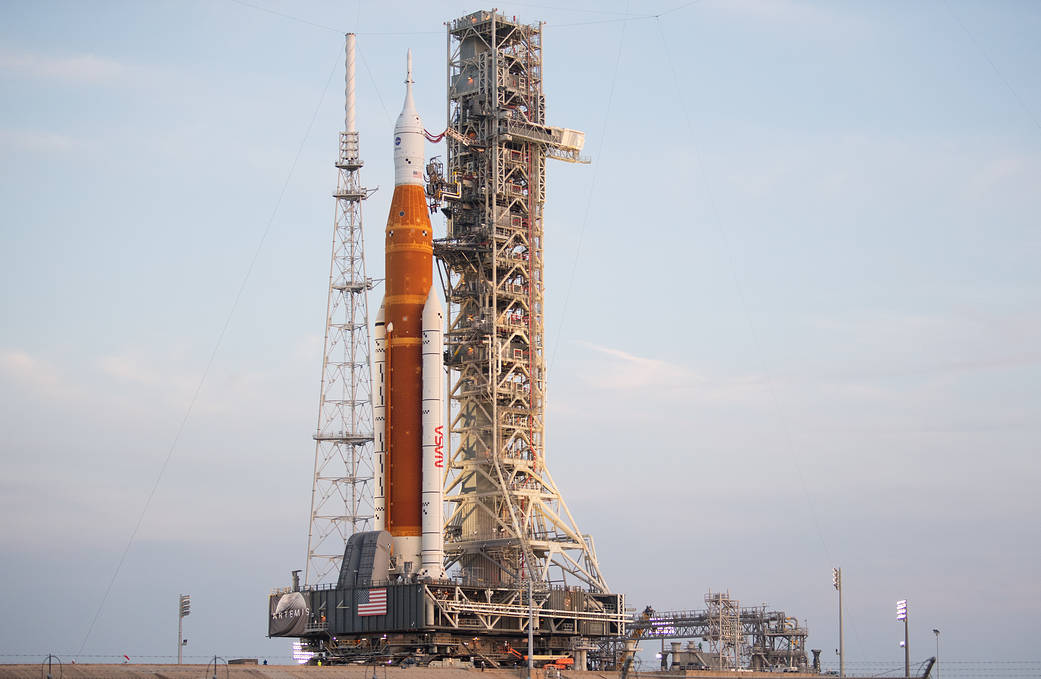
The US space agency NASA is set to launch its giant Artemis 1 rocket for its maiden flight to the moon scheduled for lift off on August 29, 2022.
The unmanned Space Launch System (SLS) mega rocket Artemis 1 is a test flight to a landmark lunar mission together with its Orion spacecraft.
It began the rollout to its Launch Pad 39B at the Kennedy Space Center launch pad in Florida at about 10 p.m. EDT (0200 GMT Wednesday, Aug. 17) and by 7:30 a.m. EDT, it had reached its destination.
The space agency chose to bring the rocket out a full two days earlier than planned. The agency said on its Artemis blog that the team finished flight termination system testing, the last major activity required before the rocket was closed out and the final access platforms at the VAB were withdrawn.
The near one hundred meter tall (328ft) SLS immense rode tractor at the KSC pad is yet to be declared a detailed schedule of the rollout by NASA, but it is expected to last between eight and eleven hours depending on weather and road conditions as well as other technical matters.
Its launch will bring the Orion spacecraft around the moon on a test of the vehicle’s system, and there will be several science webcasts and other tech onboard the mission.
The successful launch of Artemis 1 will be a key moment for NASA, which will be celebrating the half-century anniversary of Apollo 17 in December when the very last human landed on the Moon.
Artemis 1 a Preparation for a Human Mission to Mars
NASA sees a return to the Moon with Artemis 1 as a way to prepare to go to Mars with astronauts sometime in the 2030s or soon after.
It has vowed to return with its new Artemis program using technology that befits the modern era. As a side note, Artemis was the Greek god Apollo’s twin sister and goddess of the Moon.
Bill Nelson, a NASA Administrator said that “to all of us that gaze up at the Moon…dreaming of the day humankind returns to the lunar surface—folks, we’re here! We are going back. And that journey, our journey, begins with Artemis 1.”
Artemis 1 will have fifteen percent more thrust off the pad than Apollo’s Saturn V rockets. This means that its extra power combined with further enhancements will allow the vehicle to send astronauts far beyond Earth, and more equipment and cargo will be carried, as well, thus allowing crews to stay away for extended periods of time.
Orion, too, is a step up in capability because it is much more spacious, being a meter wider—at five meters (16.5ft)—than the historic command modules of the 1960s and 1970s.
Artemis 1 launch Date
Before the Monday, August 29th anticipated launch of Artemis 1, engineers will have just over a week and a half to get the vehicle ready for flight in a phase of three possible launch opportunities.
If technical issues or inclement weather prevent the rocket from launching on this date, a further attempt can be made on Friday, September 2nd or, failing that, on Monday, September 5th.
The scope of the mission is to send Orion looping around the back of the Moon before bringing it home for a splashdown in the Pacific Ocean off California.
Capsule Surviving Atmosphere Heat Upon Return
Checking if the heatshield on the capsule can survive the heat of re-entry into Earth’s atmosphere is the major objective of the test fight and a key partner in the upcoming mission in Europe.
Siân Cleaver from aerospace manufacturer Airbus said that “more than 10 countries in Europe have been working on this European Space Agency (ESA) contribution. It’s a hugely important moment for us.”
“The European Service Module is not just a payload, it’s not just a piece of equipment—it’s a really critical element because Orion can’t get to the Moon without us,” he added.
Europe hopes its contribution to this and future SLS/Orion missions will eventually see a European national get to be part of a lunar surface crew at some point.
NASA hopes to send an Artemis 2 mission to orbit the moon with people on board as soon as 2024 with a landing mission. Artemis 3 is set for 2025.
The space agency said future missions will send astronauts back to the lunar surface for the first time in over fifty years, promising that the third mission will witness the first woman putting her boots down on the Moon’s surface.
See all the latest news from Greece and the world at Greekreporter.com. Contact our newsroom to report an update or send your story, photos and videos. Follow GR on Google News and subscribe here to our daily email!



